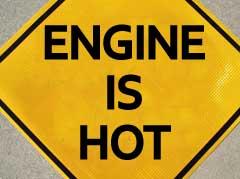Do I Need to Warm My Car Before I Drive? - Vol.189
How many times has someone told you that you should let your car sit and warm up before it is driven? This is a practice that many say is necessary to maintain your vehicle. However, is this entirely true? In the past this may have been the best practice, but is it still relevant today?

What Started This?
You may have noticed that individuals that warm their cars are typically older, and there is a reason for this. The vehicles of the past consisted of technology that was not capable of making adjustments depending on the weather. These older generations of cars had flawed fuel delivery systems, ignition systems that could not self adjust, and outdated lubricants.
For example, older fuel delivery systems used a carburetor to mix fuel for ignition. These carburetors could make adjustments for cold starts, but the process was entirely mechanical and not always reliable. Similarly, the ignition systems of older cars could not self regulate, so it was necessary to warm the car up in order to optimize the older technology's performance. In addition to this, the lubricants and fluids that were used in the past did not always flow when conditions were not optimal. This would cause surfaces within the engine to come into contact, and could cause significant scuffing and pitting.
Still Relevant?
Modern day cars have much more sophisticated systems that are entirely self-regulating. Electronic fuel injectors can make the necessary adjustments in colder weather, and, thanks to the modern day Engine Control Module, ignition systems can also compensate for less than ideal situations.
However, if you have an older model car (15-20 years old) it may be a good idea to let your car sit for about 60 seconds. Yet, with the addition of modern day lubricants and fluids, even the older model cars can tolerate the cold better.
Just in Case
People may choose to warm their vehicle anyway just to be safe. However, letting your car idle can have a few minor side effects.
First of all, idling for an extended period of time can cause inefficiencies to occur. By idling you are forcing your vehicle to run in a gasoline rich mode, which can cause long-term damage to your engine. This in turn will reduce your fuel efficiency and cost you money. In addition to this, if your vehicle has a catalytic converter then idling regularly could lead to a clog. This will also negatively impact fuel efficiency and result in dirtier emissions.
Secondly, the Environment Defense Fund has stated that idling becomes inefficient and wasteful after only ten seconds. In fact, a cold engine is known to release more unburned hydrocarbons by way of exhaust than what is typical. This is especially true when the car is remaining idle. This should put a new perspective on letting your car "warm up" for ten or fifteen minutes.
Lastly, simply driving is a much better way of warming your car. Instead of letting your car sit the next time it is cold, simply drive easy for the first minute.
Summary
Although people that warm their vehicles are doing it based on good intentions, it is not something that should be done in excess. Pollution and general wear and tear on your vehicle should be more than enough to deter individuals from this unnecessary practice. However, for those that still drive that vintage car, simply being more aware of what is happening and minimizing the time you spend idling is sufficient. Modern day automobile technology has made our lives as consumers much easier, so lets take advantage of it.